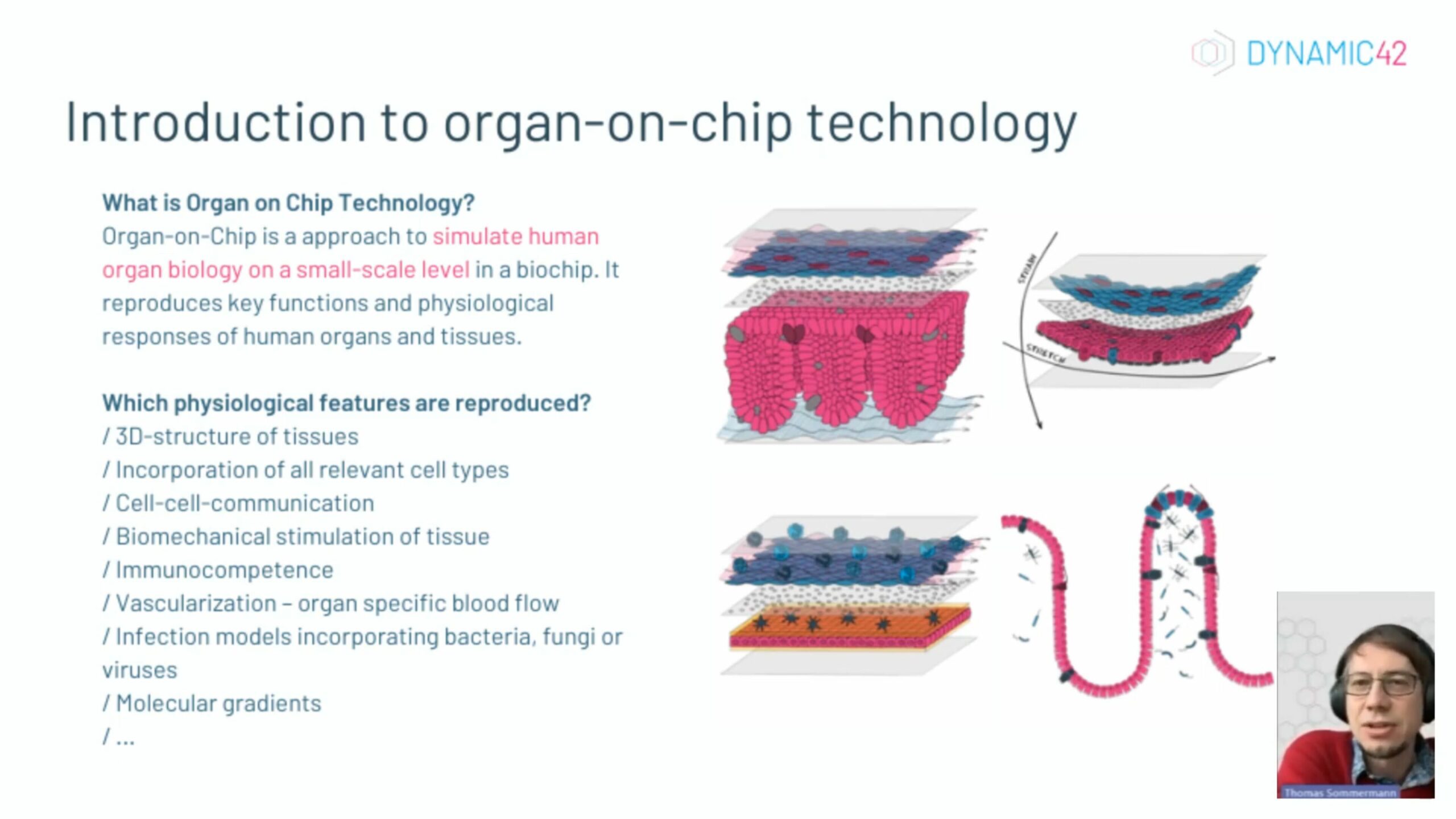
Organ-on-Chip Technology
Organ-on-chip is a technology that reproduces the biology of human organs on a biochip on a small scale. Such organ models reproduce key functions and physiological responses of human organs and tissues, providing human-relevant data for preclinical drug testing and biomedical research.
Compared to standard cell culture applications, organ models can provide more complex insights into the human body, including blood flow, immune components or even a microbiome. Mouse models provide data for the whole organism, but not always human-relevant data. Organ-on-chip technology bridges this gap.
How does organ-on-chip technology work?

Biochips with cell culture chambers, biological or biocompatible artificial membranes and a variety of channel geometries provide the conceptual basis for organ-on-chip technology. The channels of such biochips are used to introduce human cells of an organ into the cell culture chamber, to arrange, combine and separate these cells in an in vivo-like fashion and to supply these cells continuously with nutrients. They provide a frame to implement in vivo-like flow patterns similar to the human blood stream. The integrated membranes serve as scaffold to arrange human cells, to provide them structural support and a flexible substrate that can mediate mechanical stimulation. Here, complex tissues and tissue-tissue interfaces are created that facilitate intense cell-cell communication, signaling and transport processes.
Which physiological conditions and stimuli can be simulated?
Perfusion – blood flow
Different flow patterns can be achieved through the perfusion of the tissues via microfluidic pumps: pulsatile and laminar – such as in the healthy human body. The perfusion provides a crucial mechanical stimulation on the surface of human cells, especially cells from the human blood vessel system (vasculature). These shear forces influence and stimulate receptor decoration on the cell surfaces and have consequently a profound impact on cellular behavior such as growth, signaling/interaction and metabolism.

single channel perfusion

multiple channel perfusion
Biomechanical stimulation – strain & stretch

Our human body is in motion all the time and so is every tissue, most prominently blood vessels, muscles, the lung and the intestine. With Organ-on-Chip technology it is possible to apply stretch and strain onto the cells which in turn influences cellular behavior. This can be achieved via the application of flow or a direct mechanical manipulation of the tissue by deformation of biochip components.
Our human cells sense these forces via the mechanostimulatory complex – a crucial cellular sensing complex influencing various signaling pathways. This important “cellular tool” that switches on human biology is entirely neglected in standard in vitro approaches including in vitro testing.
Multicellular organ models with customizable complexity
Organ-on-Chip technology provides tremendous flexibility and potential for adaptations tailored specifically to the scope and needs of a scientific study.
Models can be scaled up from one to multiple cell types included in microphysiological settings. Increasing complexity provides maximum control of experimental design and settings. Additionally, single cell types can be easily excluded to assess their impact within the scope of your research study.

coculture 2 cell types

coculture n cell types
Molecular gradients
Molecular patterns shape biological changes and responses within our human body. The Organ-on-Chip technology enables easy application of molecular gradients. Controlled microfluidic perfusion patterns can modulate lateral distribution, especially in vascular tissues. Complex layering of cells, formation of tissue-tissue interfaces and biochip geometry can provide means to govern gradients throughout tissues.

gradient left-right

gradient bottom-top
Inclusion of the microbiome and pathogens

Microbiome
Complex organ models allow for the integration of a microbiome or pathogens to enable the establishment of disease and infection models close to the situation in vivo.
Integration of immune component

The immune system is a critical component of the human body, playing a vital role in protecting against infections, eliminating diseased cells, and maintaining tissue homeostasis. Via integration of resident and circulating immune cells, organ models can replicate the cellular complexity of the human immune system.
Dynamic42 Organ-on-Chip models
We offer services around our different Organ-on-Chip models:
Benefits of Organ on Chip technology
Increasing Biological Relevance
3dimensional settings, multicellular models that include all relevant cell types including the human immune system and the application of biomechanical cues such as perfusion improve the cell’s responsiveness and scientific data quality.
Improved prediction and risk assessment
Working in fully human settings with increased biological relevance and data quality and less animal-derived data will improve prediction and risk assessment of new drugs before entering human clinical trials.
Reduction in animal testing
The Organ-on-Chip technology bears the power to reduce animal testing significantly and sustainably in the future.
High Flexibility
Organ-on-Chip is a highly flexible technology in many ways. Applications profit from a variety of materials, technical biology-driven design possibilities and the combinations with other cutting-edge technologies such as sensors and microscopy. On a biological level, scaling of cells and cell types renders Organ-on-Chip a highly valuable tool for mechanistical studies.
Who is it for?
The Organ-on-Chip technology and our services are beneficial for a broad spectrum of users studying human biology or testing compounds aimed for use in humans.
The platform helps companies from the biotech sector and from the chemical, pharmaceutical and food industry to pre-clinically evaluate all kinds of newly developed substances that are intended for human applications. This includes a broad spectrum from small molecules and chemicals to nanomaterials and biologicals.
In addition, the Organ-on-Chip technology and concepts are well suitable to uncover basic scientific research questions. Academic scientists have the opportunity to include Organ-on-Chip models into their research to study molecular mechanisms under biologically human relevant conditions such as multicellular interaction, perfusion and biomechanical stimulation.





